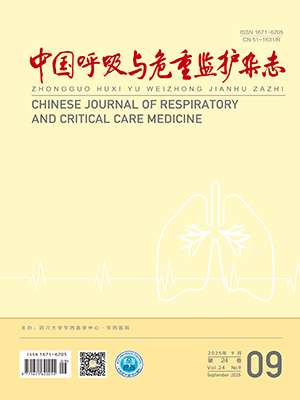| 1. |
Pelosi P, Ball L, Barbas CSV, et al. Personalized mechanical ventilation in acute respiratory distress syndrome. Crit Care, 2021, 25(1): 250.
|
| 2. |
Tonna JE, Peltan I, Brown SM, et al. Mechanical power and driving pressure as predictors of mortality among patients with ARDS. Intensive Care Med, 2020, 46(10): 1941-1943.
|
| 3. |
ARDS Definition Task Force, Ranieri VM, Rubenfeld GD, Thompson BT, et al. Acute respiratory distress syndrome: the Berlin Definition. JAMA, 2012, 307(23): 2526-2533.
|
| 4. |
孙秀梅, 陈光强, 杨燕琳, 等. 辅助通气时应用食道测压管的气囊压力-容积曲线校正食道压的可行性研究. 中华危重病急救医学, 2020, 32(7): 808-813.
|
| 5. |
邸兴伟, 李晓东, 胡占升. ARDS患者功能残气量与跨肺压的相关性以及二者对预后的预测价值研究. 中华危重病急救医学, 2020, 32(2): 166-170.
|
| 6. |
Banavasi H, Nguyen P, Osman H, et al. Management of ARDS - What Works and What Does Not. Am J Med Sci, 2021, 362(1): 13-23.
|
| 7. |
Sarge T, Baedorf-Kassis E, Banner-Goodspeed V, et al. Effect of esophageal pressure-guided positive end-expiratory pressure on survival from acute respiratory distress syndrome: a risk-based and mechanistic reanalysis of the EPVent-2 Trial. Am J Respir Crit Care Med, 2021, 204(10): 1153-1163.
|
| 8. |
Coppola S, Caccioppola A, Froio S, et al. Effect of mechanical power on intensive care mortality in ARDS patients. Crit Care, 2020, 24(1): 246-255.
|
| 9. |
夏金根, 詹庆元. 应用食道压力指导急性呼吸窘迫综合征患者呼气末正压的设置. 中国呼吸与危重监护杂志, 2019, 18(2): 189-192.
|
| 10. |
唐敏, 李娜. 急性呼吸窘迫综合征发病机制及相关生物标志物的研究进展. 中国现代医学杂志, 2022, 32(5): 1-6.
|
| 11. |
谢永鹏, 钱颖, 刘克喜, 等. ARDS患者机械功与肺部超声评分的相关性以及二者对预后的评估价值. 中华危重病急救医学, 2019, 31(6): 704-708.
|
| 12. |
怀佳萍, 蒋晨琳, 邓鸿胜, 等. 肺泡灌洗液炎性因子对急性呼吸窘迫综合征患者肺复张潜能的评估价值. 中国全科医学, 2023, 26(3): 329-334.
|
| 13. |
Su PL, Zhao Z, Ko YF, et al. Spontaneous breathing and pendelluft in patients with acute lung injury: a narrative review. J Clin Med, 2022, 11(24): 7449.
|
| 14. |
Madahar P, Talmor D, Beitler JR. Transpulmonary pressure-guided ventilation to attenuate atelectrauma and hyperinflation in acute lung injury. Am J Respir Crit Care Med, 2021, 203(8): 934-937.
|




